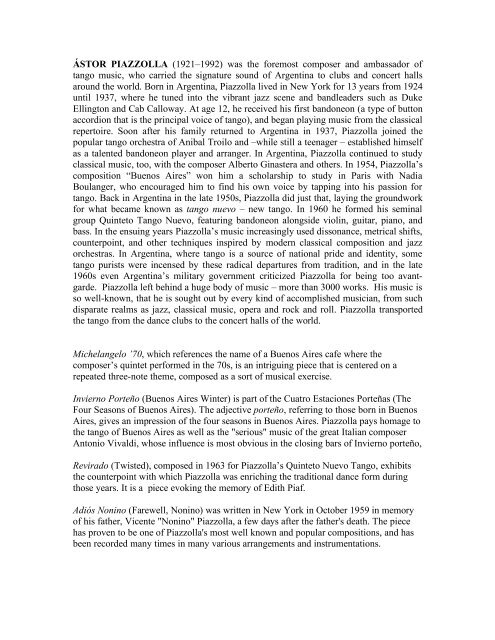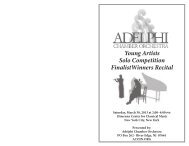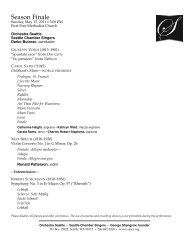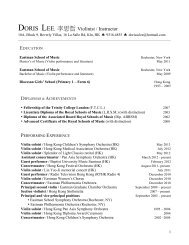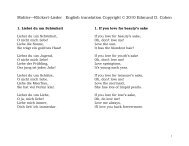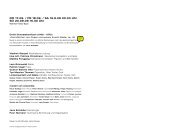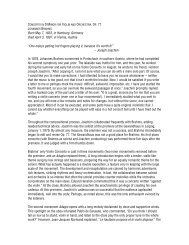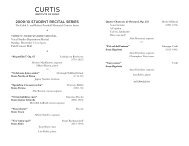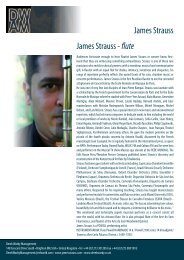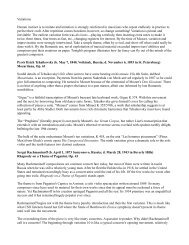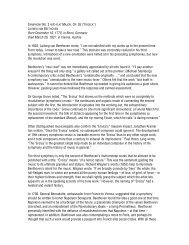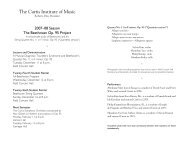PIAZZOLLA TANGOS program notes - InstantEncore
PIAZZOLLA TANGOS program notes - InstantEncore
PIAZZOLLA TANGOS program notes - InstantEncore
Create successful ePaper yourself
Turn your PDF publications into a flip-book with our unique Google optimized e-Paper software.
ÁSTOR <strong>PIAZZOLLA</strong> (1921–1992) was the foremost composer and ambassador of<br />
tango music, who carried the signature sound of Argentina to clubs and concert halls<br />
around the world. Born in Argentina, Piazzolla lived in New York for 13 years from 1924<br />
until 1937, where he tuned into the vibrant jazz scene and bandleaders such as Duke<br />
Ellington and Cab Calloway. At age 12, he received his first bandoneon (a type of button<br />
accordion that is the principal voice of tango), and began playing music from the classical<br />
repertoire. Soon after his family returned to Argentina in 1937, Piazzolla joined the<br />
popular tango orchestra of Anibal Troilo and –while still a teenager – established himself<br />
as a talented bandoneon player and arranger. In Argentina, Piazzolla continued to study<br />
classical music, too, with the composer Alberto Ginastera and others. In 1954, Piazzolla’s<br />
composition “Buenos Aires” won him a scholarship to study in Paris with Nadia<br />
Boulanger, who encouraged him to find his own voice by tapping into his passion for<br />
tango. Back in Argentina in the late 1950s, Piazzolla did just that, laying the groundwork<br />
for what became known as tango nuevo – new tango. In 1960 he formed his seminal<br />
group Quinteto Tango Nuevo, featuring bandoneon alongside violin, guitar, piano, and<br />
bass. In the ensuing years Piazzolla’s music increasingly used dissonance, metrical shifts,<br />
counterpoint, and other techniques inspired by modern classical composition and jazz<br />
orchestras. In Argentina, where tango is a source of national pride and identity, some<br />
tango purists were incensed by these radical departures from tradition, and in the late<br />
1960s even Argentina’s military government criticized Piazzolla for being too avantgarde.<br />
Piazzolla left behind a huge body of music – more than 3000 works. His music is<br />
so well-known, that he is sought out by every kind of accomplished musician, from such<br />
disparate realms as jazz, classical music, opera and rock and roll. Piazzolla transported<br />
the tango from the dance clubs to the concert halls of the world.<br />
Michelangelo ’70, which references the name of a Buenos Aires cafe where the<br />
composer’s quintet performed in the 70s, is an intriguing piece that is centered on a<br />
repeated three-note theme, composed as a sort of musical exercise.<br />
Invierno Porteño (Buenos Aires Winter) is part of the Cuatro Estaciones Porteñas (The<br />
Four Seasons of Buenos Aires). The adjective porteño, referring to those born in Buenos<br />
Aires, gives an impression of the four seasons in Buenos Aires. Piazzolla pays homage to<br />
the tango of Buenos Aires as well as the "serious" music of the great Italian composer<br />
Antonio Vivaldi, whose influence is most obvious in the closing bars of Invierno porteño,<br />
Revirado (Twisted), composed in 1963 for Piazzolla’s Quinteto Nuevo Tango, exhibits<br />
the counterpoint with which Piazzolla was enriching the traditional dance form during<br />
those years. It is a piece evoking the memory of Edith Piaf.<br />
Adiós Nonino (Farewell, Nonino) was written in New York in October 1959 in memory<br />
of his father, Vicente "Nonino" Piazzolla, a few days after the father's death. The piece<br />
has proven to be one of Piazzolla's most well known and popular compositions, and has<br />
been recorded many times in many various arrangements and instrumentations.
Primavera Porteña (Buenos Aires Spring) was composed by Piazzolla in 1970. It starts<br />
with a fugue and stands out with its strong elements of counterpoint. As in the rest of the<br />
“Buenos Aires Seasons”, this movement’s title is general enough to avoid suggesting any<br />
specific visual images. The result is purely abstract music, passionate, dark, romantic,<br />
rhythmically complex and imbued with the spirit of tango.<br />
S.V.P. (S’il Vous Plait) was one of the first tangos composed by Astor Piazzolla, while he<br />
studied with Nadia Boulanger in Paris. While not yet “tango nuevo”, its charm and<br />
melancholic mood seduce the listener with bittersweet tenderness.<br />
Decarisimo was written as a Thank You note to Julio De Caro, a tango innovator, who<br />
paid homage to Piazzolla by writing a tango bearing Piazzolla’s name. Piazzolla<br />
respected and appreciated De Caro, whose ideas had guided and inspired him.<br />
Otoño Porteño (Buenos Aires Autumn) starts with “chicharra” (cicada), Piazzolla's<br />
trademark effect, a raspy, cricket-like sound, generated when the bow is scraped over the<br />
wrapping of the string. Two versions of an energetic theme surround a central, reflective<br />
version. The music is quintessential Piazzolla: reflecting the life and soul of his native<br />
Buenos Aires.<br />
Escualo (Shark), composed in 1979 for the famous tango violinist Fernando Suarez Paz,<br />
refers to shark-fishing, Piazzolla’s favorite pastime while vacationing in Punta del Este,<br />
Uruguay. This work is one of the most rhythmically challenging among Piazzolla’s<br />
compositions, and is famously known as the most difficult to perform on the violin.


